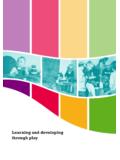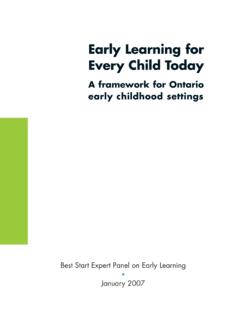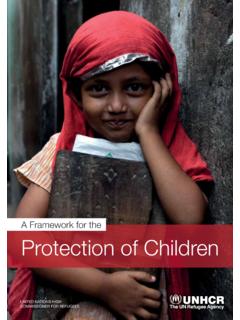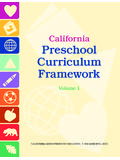Transcription of Learning and developing through interactions - …
1 Learning and developing through interactions27 Learning and developing through interactionsAistear: the Early Childhood Curriculum framework IntroductionRelationships are at the very heart of early Learning and development. through their early interactions babies learn to feel secure, to communicate, and to enjoy being with people. As they grow and develop, toddlers and young children love to play, to chat, to watch, and to be with others. children build relationships, communicate, express love and affection, play together, learn, and have their needs met through contact with others.
2 These guidelines identify a range of interaction strategies and methods which the adult can use to enhance children s Learning and development. How can I have good interactions with children ?Good adult/child interactions are respectful, playful, enjoyable, enabling, and rewarding. through these the adult respects all children as individuals with rights builds on children s abilities, interests, experiences, cultures, and backgrounds, provides for their needs and facilitates them to initiate activities, to make choices, and to become increasingly independent and responsibletakes account of additional needs or supports children may require in order to participate as fully as possiblegives children feedback on what they are doing, names and affirms their efforts, celebrates their progress and achievements.
3 And helps them to learn from mistakes, setbacks and challenges (See the guidelines, Supporting Learning and development through assessment.)establishes and maintains good relationships with children s families (See the guidelines , Building partnerships between parents and practitioners).Many interactions just happen while others come about through careful planning and decision-making. The above factors, the relevant aim(s) and Learning goal(s) in Aistear, and the activities being undertaken all influence the adult s decisions about when and how to interact with children .
4 His/her expertise, experience and view of his/her role in fostering children s Learning and development also influence the types of interactions the adult has with children . In addition, some children require significant support for extended periods of time, while others require less and over shorter timeframes. As outlined in the guidelines, Building partnerships between parents and practitioners, children s Learning and development are also shaped by relationships with the important people in their lives. In out-of-home settings parents, practitioners and other professionals, such as social workers and speech therapists, work together for the benefit of children .
5 Positive and respectful interactions between all the adults in their lives influence how children interact with others. Thinking about my practice1. What personal and professional development could I take part in to support my interactions with children (for example Learning to use digital recordings to support adult reflection)?2. How do I interact with members of staff, outside agencies, and other professionals?28 Learning and developing through interactionsAistear: the Early Childhood Curriculum framework What interaction strategies can I use?
6 These guidelines focus on four strategies as presented in Table 2. Those in the first two columns of the table see children leading Learning , with the adult in an enabling role. In this role, the adult organises the environment, observes the children s experiences, models behaviours and Learning , establishes shared understanding and meaning, and reflects on what is happening. Using the strategies in the third and fourth columns of Table 2 the adult directs Learning by taking a more proactive role, giving feedback, leading an activity, or joining in as appropriate.
7 During early childhood it is important that children have opportunities to lead Learning through self-initiated and self-directed Learning , and to be involved in decisions about what they do. At other times, the adult leads through planned and guided activities and increases or lessens the amount and type of support as children grow in confidence and competence. Tables 3 to 6 present short descriptions of some methods in each of the four strategies. The methods are presented alphabetically. Further information is also provided when six methods are discussed in detail on pages 31 to 51.
8 There is some inevitable overlap between strategies and 2: A range of interaction strategiesBuilding RelationshipsFacilitatingOrganisingDirec tingChildren learn by being with others. This strategy includes methods which the adult uses to build relationships and to create an environment in which children feel secure and confident enough to take risks, to explore, to take part in challenging experiences, and to direct and co-direct their own learn by being involved in making choices and decisions, and by feeling in control. Learning is enjoyable and rewarding for them when they challenge themselves and when they can use and build on their existing knowledge, understanding and skills.
9 They enjoy Learning through child-initiated activities. This strategy includes methods which the adult uses to encourage children to take the lead or to share the lead with learn in a well-planned and well-resourced environment. The environment represents all children in the setting and makes Learning challenging and fun. This strategy includes methods which the adult uses to create and maintain such an environment, including reflecting on the Learning that is occurring in the environment and planning ways to enhance learn through planned and guided activities which build on their interests and experiences.
10 This strategy includes methods which the adult uses to focus on children s Learning and to develop particular dispositions, values and attitudes, skills, knowledge, and Lead Learning The Adult Leads Learning29 Learning and developing through interactionsAistear: the Early Childhood Curriculum framework Table 3: Building relationships Sample methodsThe adultAccepting and valuing children , their families and communitieswelcomes all children , their families and communities finds out about each child s interests, background, values, and traditions provides props, toys, books, and displays which represent all children in the setting helps children to learn about their communities Engaging, discussing and communicating joins with children in their play, activities and discussions shares jokes and funny stories.









